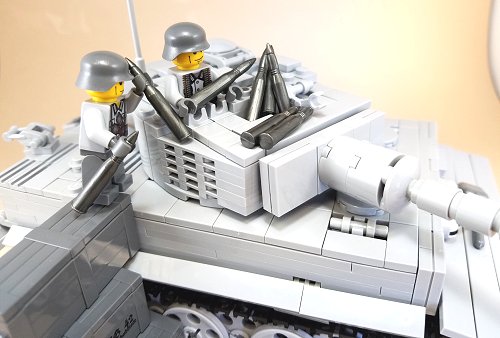
218 took part in crushing the Warsaw uprising, then incorporated into the Sturmpanzer Abteilungen noted above. At least two companies of Brummbär-equipped units are known: Sturmpanzer -Kompanie z.d.V. Sturmpanzer-Abteilung 219 fought against the Soviets in the Budapest area. Sturmpanzer-Abteilung 218, raised in August 1944, fought against the Warsaw Uprising, then remained on the Eastern Front until destroyed in East Prussia, in April 1945. As an independent battalion, it next saw service at Anzio in Italy, and from then to the end of the war it withdrew north until the battalion was forced to destroy its remaining vehicles and surrender in the Po valley. Afterwards, it withdrew to defensive positions to repel the Soviet offensive around Orel. Sturmpanzer-Abteilung 216 first saw action at Kursk, when it formed the 4th battalion of Panzerjaeger 656, where it got as far as Ponyri. The Brummbär primarily saw service in 4 battalions, Sturmpanzer-Abteilungen 216, 217, 218, and 219. Krupp also built one prototype of a proposed Jagdpanzer IV with a 8.8 cm Pak 43 L/71. The only variant of the Brummbär was a command vehicle, Befehlsturmpanzer IV.

Previous models had a MG 34 mounted on the commander’s cupola.
WW2 ONLINE 88MM SERIES
With Series 4 a new, lighter gun eased the problem considerably in addition, a MG 34 was mounted for close defense. – Series 4: June 1944-March 1945 Built at the Deutsche Eisenwerke on Ausf.J chassis.īecause of the weight of the gun, there were problems with the suspension of the Brummbär. – Series 3: March-June 1944 Built at Vienna Arsenal. – Series 2: December 1943-March 1944 60 built at the Vienna Arsenal using Ausf.J chassis. – Series 1: April 1943 60 built by Vienna Arsenal, with 52 using Panzer IV Ausf.G and 8 using rebuilt Ausf.E chassis. There were four series built as follows, all using variants of the Panzer IV chassis. Sources conflict as to how many were built, either 306 or 313. Also, the Zimmerit anti-magnetic coating was factory-applied until September 1944. The decision was taken in October 1943 and after the redesign, 800 kg (1,800 lb) of steel were spared, including from the gun mount itself on the third series. The second series corrected this issue with a newly shaped, lighter casemate. The first production vehicles proved their superstructure was way too heavy for the chassis, and experienced breakdowns of suspension elements or the transmission. By the time these vehicles were ready, spaced armor became the norm and Schürzen plates were factory-fitted.

Ventilation of the casemate’s fumes and heat was provided by natural convection, exiting through two armored covers at the back of the roof.
WW2 ONLINE 88MM DRIVER
The driver was located forward, slightly in front of the casemate, and was given the Tiger I Fahrersehklappe 80 sight. In addition, early vehicles carried a MP 40 sub-machine gun intended to be fired through the two firing ports on each side of the superstructure.

Outside the main howitzer, a single MG 34 machine gun could be fastened to the open gunner’s hatch, in the same way as for the Sturmgeschütz III Ausf.G. The top and bottom were protected by 10 mm (0.39 in) of armor at 90°. Indeed, this thickness was 100 mm (3.93 in) at a 40° angle on the front, 40 mm/12° (1.57 in) for the front hull, 50 mm/15° (1.97 in) for the side superstructure, 30 mm (1.18 in) for the side of the hull and 30 mm /25°/0° (1.18 in) for the rear of the casemate and 20 mm /10° (0.79 in) for the back of the hull. The howitzer was protected by a casemate with sloped sides and thick armor plates. The gunner set up the trajectory and aimed the gun using a Sfl.Zf.
WW2 ONLINE 88MM MANUAL
However, these massive rounds had a combined weight of 46 kg (38 kg/84 lb for the High Explosive shell itself and 8 kg/18 lb for its propellant cartridge), which made manual loading especially arduous on some elevations. 38 rounds with their separate propellant cartridges were carried, stored in the casemate and the hull. Above it, Alkett fitted a massive 15 cm (5.9 in) Sturmhaubitze (StuH) 43 L/12 developed by Škoda, which had common ammunition with the standard siG 33 howitzer in German service.

The chassis was the one of the reliable, mass-produced Panzer IV. If you spot anything out of place, please let us know! Hello dear reader! This article is in need of some care and attention and may contain errors or inaccuracies. They referred to it casually as the Stupa 43. Although commonly referred to as the Brummbär, this was the nickname given to the Sturmpanzer 43 by Allied intelligence, not by the Germans. Alkett received the order to design the new vehicle, which would be known as the Sd.Kfz.166, Sturmpanzer, or Sturmpanzer 43. In 1942, Albert Speer placed an order for a howitzer mounted on a tank chassis to keep up with the Panzer Divisions. Heavy Assault Gun – 303-316 Built Development of the Sd.Kfz.166


 0 kommentar(er)
0 kommentar(er)
